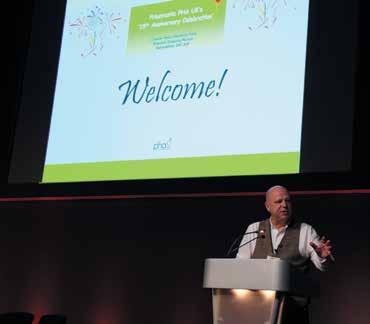
6 minute read
National Audit of PH
from Emphasis Winter 2015
by PHA UK
The PH National Audit The National Audit of PH has been running for five years now. But what’s it all about? Here, Simon Gibbs gives an overview of this important statistical exercise to Steph Pollard.
The NHS’ specialised service for PH benefits from one of the most robust, routine monitoring exercises in the UK – if not the world.
The NHS’ specialised service for PH benefits from one of the most robust, routine monitoring exercises in the UK – if not the world.
The National Audit of PH has almost unprecedented levels of engagement, with every PH centre in the country recording key facts and figures about assessments, diagnoses, treatments, therapies and outcomes on a day-to-day basis.
This thorough data collection provides statistical evidence to inform and support our long-term understanding of PH as a disease as well as our knowledge of patients’ experiences and how PH services are delivered.
Simon Gibbs
It informs decisions about planning, funding and improving services for the future – and could help protect services against any potential cuts in a cashstrapped NHS too.
The National Audit’s founder and lead clinician Simon Gibbs says: “We are very fortunate to have 100 per cent participation in the PH National Audit and we really appreciate everyone’s efforts to input this data on a regular basis at all eight PH specialist centres.
“This input makes this one of the most effective audits of a specialised service for a rare condition carried out in the UK – if not the world.
“And it means the data is as robust as possible and provides an excellent rolling review of PH services and patient experiences which can be monitored, measured and reviewed year-on-year.”
Simon put his proposal forward for a National Audit of PH more than five years ago and PHA UK played a vital role in setting up the project by funding the very first audit in 2009.
It is now funded via NHS Specialised Commissioning in England, and managed by the Health and Social Care Information Centre (HSCIC) in Leeds.
Simon said: “The charity’s funding to get the audit off the ground was crucial. It laid the groundwork for future audits and showed what could be done. It undoubtedly helped to secure long-term NHS funding for this important work with the HSCIC.”
Simon explains here how the National Audit works:
Each specialist PH centre in the UK records data on patients for their own use such as visits, investigations, drugs prescribed and so on. This data is then also fed to the audit database at the HSCIC. All this information gathering is done in accordance with the relevant legal statues for the country the centre is in (for example the Data Protection Act 1998 and the Health and Social Care act 2001 for England). If any patient wishes to not take part they should inform the hospital treating them; and all patients can be sure that being removed from the audit will not affect the quality of care they receive.
The data is then analysed, verified and published by the Health and Social Care Information Centre (HSCIC) in its annual ‘National Audit of Pulmonary Hypertension’ report; which is a series of tables of charts which make sure no individual is identified.
Information about this national audit can be found in the leaflet 'What is the National Audit of Pulmonary Hypertension?' which is available from the PHA UK or your hospital’s PH service.
The report is aimed at health professionals and policy makers to work with, and is also published online
by HSCIC, available for all to see.
For example, this year’s report showed that 8,431 patients were seen at PH centres in the previous year. During those 12 months, 4,126 patients received targeted drug therapy. And of the new PH patients starting therapies, 81 per cent were prescribed sildenafil as the first line drug.
The 2014 report also includes new analysis on diagnosis and therapy, analysis by specialist centre, a comparison of operated and not operated chronic thromboembolic pulmonary hypertension, and an analysis of distance from a specialist centre as an influence on referral patterns.
The audit’s purpose is to help further improve the quality and safety of care and its clinical and cost effectiveness. NHS England relies on such statistical evidence to inform its decisions about planning the future of all services.
Simon, consultant cardiologist at Hammersmith Hospital in London, chairs the National Audit of PH project board and works closely with HSCIC on the audit, leading on some analysis of the data.
Simon said: “The analysed data we gather through audit helps us monitor all sorts of things from simply how many people are diagnosed with PH each year to which drugs and treatments are being prescribed for PH and outcomes for patients.
“It maps the delivery of the service across the UK and enables us to enquire into certain aspects of care or identify and monitor any changes. It provides accurate clinical data about the progression of the disease. “All of this information provides evidence of PH services’ activity and impact on patients which all helps to protect, review and develop services.
“As a PH community, we should be very proud that we work together to deliver this audit in support of the provision of high quality care in PH services.” All five National Pulmonary Hypertension Audits are available to view online at www.hscic.gov.uk . “Advances in medical science have introduced important new therapies to the treatment of different forms of pulmonary hypertension... As with other uncommon diseases these developments have brought the need to establish a specialist service, where experience and expertise can grow, audit and research can flourish, and so provide the most up-to-date care of the highest quality. This national audit … makes a detailed assessment of the clinical epidemiology of the condition; the service demand… the pathways of diagnosis and treatment; and the outcomes over time. It supports studies to better understand the natural history of these conditions, to guide diagnostic and treatment strategies and clinical research.”
Professor Dame Carol Black, writing in the first National Audit of PH (published 2010)
“The NHS continues to strive to provide high quality equitable care in a very challenging environment. Nowhere is this challenge greater than in the provision of services for rare diseases. Audit is key in improving outcomes for patients and in helping to plan how we deliver our services. In an environment where resources are finite it is key we ensure that these are used carefully. Over the five years since its inception, the quality of data in the audit has continued to improve and we are now able to not only provide data on outcomes, but also understand more about the forms of pulmonary hypertension that we see in our specialist services. This information will be key in ensuring that the UK continues to provide high quality care for patients and their families over the coming years.”
Professor David Kiely, Chair of UK and Ireland Pulmonary Hypertension Physicians Committee, writing in the latest National Audit of PH (published 2015)
The National Audit of Pulmonary Hypertension involves an alliance of NHS professional bodies including PHA-UK; all the clinicians and audit database users at each PH centre; NHS England; the Pulmonary Hypertension Clinical Reference Group of the NHS Commissioning Board; the National Services Division, NHS Scotland; Welsh Health Specialised Services Committee, Northern Ireland Local Commissioning Group, and the Health and Social Care Information Centre.










